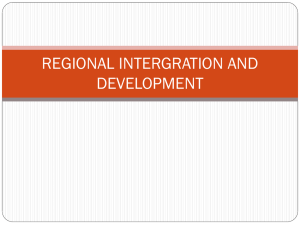Presentación Colombia - Organization of American States
advertisement
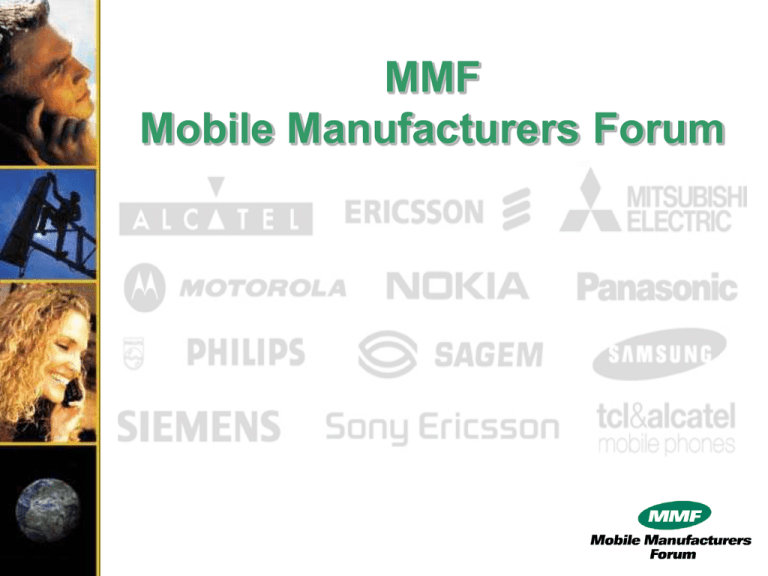
MMF Mobile Manufacturers Forum MMF/Perfil MMF is an international association of wireless telecommunications equipment manufacturers. Based in Belgium since 1998. Representing around 90% of world cellular telephones sales and the majority of global network infrastructure providers. “Hub” for Latin America since January 2003 (Sao Paulo, Brazil). Alcatel BenQ Ericsson Mitsubishi Motorola Nokia Panasonic Philips Sagem Samsung Siemens Sony-Ericsson tcl&Alcatel MMF/Profile Focal point for telecommunications, EMF, and health, with particular emphasis on: • Assistance for scientific research - Independent organizations. - Partial financial support. - WHO research agenda. • Guidelines and harmonization of standards - Support for governing agencies and bodies worldwide. • Communication of reliable, up-to-date information on the issue, targeting interested segments (business associations, specialized press, government officials, etc.) as well as the general public. Communication and Controversy EMF and Health: Why the controversy? • Electromagnetic fields are invisible, which generates concern. • The difference between verification of a biological effect and injury to health. • It is normal for scientific results and procedures not to be perfectly understood. • Negative effects reported often are not replicable, but the original scientifically unproven information remains for the public. • Technical information on ionizing radiation (such as radioactivity), is mistakenly associated with the (non-ionizing) radio frequency of mobile telephones. EMF and Health: Why the controversy? • The comments of “experts” may not represent a scientific truth. • Basing the result on a single study - No isolated study can provide a definitive answer to a scientific question. • Weight of the evidence – All existing scientific evidence should be considered as a whole. Scientifically, an isolated study cannot be regarded as definitive. • Conclusions must be based on consensus and accumulated evidence. A reliable scientific position World Health Organization: “None of the recent reviews have concluded that exposure to the RF fields from mobile phones or their base stations causes any adverse health consequence.” “International guidelines have been developed to protect everyone in the population: mobile phone users, those who work near or live around base stations, as well as people who do not use mobile phones.” http://www.who.int/peh-emf/en/ A reliable scientific consensus Consensus of international organizations: there is no scientific evidence of adverse health effects under international (ICNIRP) guidelines. – World Health Organization (WHO) – International Commission on Non-Ionizing Radiation Protection (ICNIRP). – Scientific Committee on Toxicity, Ecotoxicity and the Environment (CSTEE), EU – National Radiological Protection Board, UK – Royal Society of Canada Expert Panel – Independent Expert Group on Mobile Phones, UK – – – – – – French Government Experts Report German Health Council FDA, USA American Cancer Society, USA Health Sciences Authority, Singapore Ministry of Health of Spain Scientific Research Table 1: Studies reviewed by the international scientific community with a description of the biological and health effects of RF fields: Type of Study/&Research In Progress (1) Announced Not Published (1) Published (2) Epidemiological………………….. 44 09 205 On Humans…..………………….. 65 17 160 On Animals ………….…………… 50 30 715 Cell studies ……………………. 67 31 391 226 87 1492 TOTAL All the studies appear on the WHO website: http://www.who.int/peh-emf/research/database/en/ 1. From WHO Project Listings. 2.IFrom WHO citation listings. Scientific Research Table 2: Studies on mobile telephones in the WHO database: In Progress Type of Study/Research Completed* Total Cancer-related Epidemiological………………….. On Animals……………………..… Cell studies ……..……………….. 31 17 46 55 68 80 86 85 126 Subtotal 94 203 297 Non cancer-related Epidemiological..………………… On humans…..……………………. On animals……………..………….. Cell studies………………………… 7 59 27 11 16 98 107 26 23 157 134 37 Subtotal 104 247 351 198 450 648 TOTAL All the studies appear on the WHO website : http://www.who.int/peh-emf/research/database/en/ * One completed study = one or more papers published. Why research further? • A larger scientific database leads to more definitive evaluations by public health authorities and, therefore, increases public faith in the system and products. Defining Standards Defining Guidelines • Based on recommendations of an independent scientific organization, whose credibility is recognized by the international scientific community, adopted by the majority of other countries, for definition of limits. • The limits should provide users, workers, and the public at large with substantial protection (with a safety margin), and, thanks to the credibility of their origin, they will not call for the adoption of special additional precautionary criteria. • The limits should function amply and allow all current technologies relating to the issue to do so (realistic). Defining Guidelines • They should provide recognized, sound scientific criteria for the internal consideration and discussion of health matters relating to Radio Frequency. • They should make it possible to create consistent rules for manufacturing companies and telecommunication operators. • Thanks to their reliable origin, they should give added credibility to the regulating agencies as protectors of public health. Challenges in Defining Guidelines • Government and industry should act in conjunction to explain the safety of the defined standards to the population (communication!). • They should be compatible with the standards of international organizations (CITEL, ITU, WTO), thereby guaranteeing the non-exclusion of the country from the current globalized international context. • Standards for the certification of equipment should be internationally uniform to ensure technological agility. Importance of Harmonization - Guidelines and Regulatory Aspects Harmonization of Guidelines • The WHO approves and encourages the harmonized adoption of the ICNIRP: “International standards were developed to protect the whole population: users of mobile telephones, and those who work or live near base stations, as well as non-users of mobile telephones.” http://www.who.int/peh-emf/en/ • The following also recommend harmonization by ICNIRP: - ITU – International Telecommunication Union (ITU-TK.52(02/00); - CITEL – Inter-American Telecommunication Commission - WTO – World Trade Organization Importance of Harmonization • ITU/WTO/WHO • Internal and external credibility – Based on recommendations of an independent scientific organization whose credibility is recognized by the international scientific community. • International recognition – Internationally recognized protection levels (safety margin). For users, workers, and the general public. Importance of Harmonization • Technological Frontiers – Limits that work efficiently and enable all last generation technologies to do so. • Clear Rules – Easily understood rules for manufacturing and operating companies in an increasingly globalized business environment. Benefits of adopting the ICNIRP All parties win with the adoption of ICNIRP guidelines: • Consumers win with the protection of internationally recognized safety standards, and by obtaining equal access to products and services available for consumers throughout the world. • Regulating agencies win by gaining access to consistent regulations, scientifically based on the recommendations of the WHO-World Health Organization, the ITU-International Telecommunication Union, and the WTO-World Trade Organization. • Industry gains by developing and manufacturing products that conform to widely accepted international standards, and by putting these products on sale around the world, in a safe and timely manner. Adoption of ICNIRP Countries with standards that follow WHO recommendations: Australia Japan Brazil UK Portugal Ireland Peru Poland Lithuania Cyprus Ecuador Singapore USA Israel France Denmark Greece Sweden Hungary Malta Estonia Taiwan Hong Kong N. Zealand Spain Finland Luxembourg Norway Czech Rep. Slovenia Argentina Korea Canada Belgium Italy Germany Holland Turkey Latvia Slovakia Colombia Some Practical Recommendations Practical Recommendations • Expedite adoption of harmonized exposure guidelines It is highly recommendable that appropriate standards be adopted before the issue becomes emotionally charged, with consequences in the political area (urban myth). • Show compliance with the guidelines This is the way to build confidence. • Undertake, and communicate results of audits/reviews By Government or Industry. This helps to build confidence. • Importance of industry cooperation Health is a non-competitive aspect. Develop common tools such as templates to help site planners. Practical Recommendations • Consult the community in emotionally sensitive places The sooner the better. Listen to suggestions made by the community • Create information for the consumer Leading to key interests, and which can be directed by independent sources. • Well thought-out selection and design of sites Use designs that will minimize visual preoccupation and invasion. • Use joint location In special sites (this minimizes costs and impacts). But the visual impact should also be taken into consideration. Aderbal Bonturi Pereira Director for Latin America Centro Empresarial Paulista Av. Paulista, 2300 Piso Pilotis CEP 01310-300 São Paulo-SP Brazil Phone.: 55 11 6847 4610 Fax: 55 11 6847 4550 Mobile: 55 11 9233 9899 E-mail: aderbal.pereira@mmfai.info Internet: www.mmfai.org
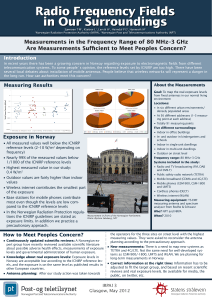
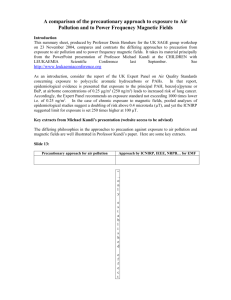
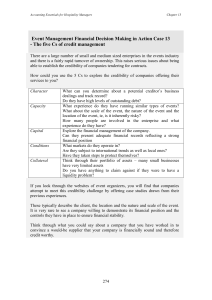
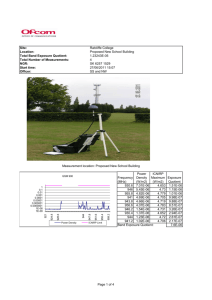
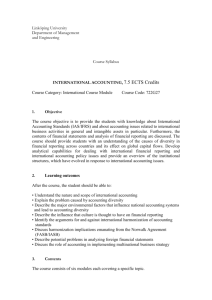

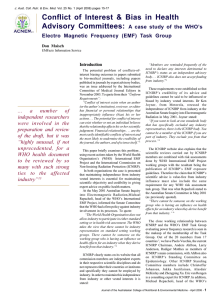

![DEV0901 MIP parish council presentation[6]](http://s2.studylib.net/store/data/005501760_1-b6d93abfa534491f514ad86cf7fcdf40-300x300.png)
